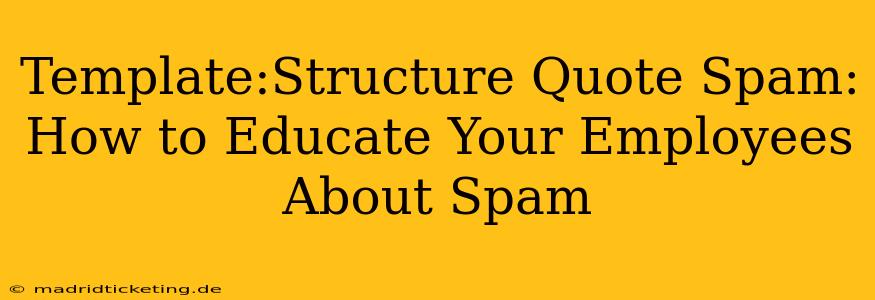Structure quote spam is a sophisticated form of email fraud that's rapidly becoming a major concern for businesses. Unlike typical spam, it cleverly manipulates legitimate email threads, inserting fraudulent quotes or invoices into ongoing conversations. This makes it harder to detect and significantly increases the risk of financial loss. Educating your employees about this evolving threat is crucial for protecting your company's finances and reputation. This comprehensive guide provides actionable steps to help you train your staff on identifying and avoiding structure quote spam.
What is Structure Quote Spam?
Structure quote spam, also known as quote injection or reply chain spam, works by inserting malicious content into legitimate email conversations. Hackers often compromise email accounts or exploit vulnerabilities in email systems to insert fraudulent quotes or invoices seemingly originating from a trusted contact. The key characteristic is its integration within an existing email thread, lending it an air of authenticity. The fraudulent quote might slightly alter a genuine quote, changing payment details or introducing fake products or services.
How Does Structure Quote Spam Work?
The mechanics of structure quote spam are often intricate, but generally follow these steps:
- Compromised Account: Hackers gain access to an email account, either through phishing, malware, or other means.
- Monitoring Conversations: They monitor ongoing email exchanges, particularly those involving business transactions or quotations.
- Injection of Malicious Content: At a strategic point in the conversation, they insert a fraudulent quote or invoice, subtly altering the original details.
- Camouflaging: The malicious content is often expertly integrated into the email thread, making it difficult to distinguish from legitimate communication.
- Financial Fraud: The unsuspecting recipient then processes the fraudulent payment, resulting in financial loss for the company.
How to Identify Structure Quote Spam: Key Indicators
Identifying structure quote spam requires vigilance and attention to detail. Here are some red flags to look out for:
- Unexpected changes in payment details: Scrutinize bank account numbers, routing numbers, and payment methods. Any discrepancies warrant immediate investigation.
- Unfamiliar email addresses or domains: Even if the email thread appears legitimate, check the sender's email address for inconsistencies or unfamiliar domains.
- Unusual wording or grammar: Malicious emails may contain grammatical errors or slightly altered phrasing compared to previous communications.
- Discrepancies in amounts or products: Verify the amounts, products, or services mentioned against previous communications and purchase orders.
- Urgent requests for payment: Be wary of emails demanding immediate payment, especially without proper verification.
- Suspicious links or attachments: Never click on links or open attachments from suspicious emails.
How to Educate Your Employees About Structure Quote Spam
Effective training is paramount in mitigating the risks associated with structure quote spam. Here’s a structured approach:
1. Regular Security Awareness Training:
Include structure quote spam as a key topic in your ongoing security awareness training programs. Use real-world examples and case studies to illustrate the threat.
2. Simulated Phishing Campaigns:
Conduct regular simulated phishing campaigns to test employee awareness and identify vulnerabilities. This provides valuable training and highlights areas needing improvement.
3. Emphasis on Verification:
Stress the importance of independently verifying all quotes and invoices, even if they appear to be part of a legitimate email conversation. Encourage employees to contact the sender directly via phone or through a known contact method to confirm the details.
4. Promote a Culture of Caution:
Foster a workplace culture where employees feel comfortable reporting suspicious emails without fear of reprisal.
5. Strong Password Policies and Multi-Factor Authentication:
Implement strong password policies and enforce multi-factor authentication to protect employee email accounts from unauthorized access.
Frequently Asked Questions (FAQs)
How can I verify the authenticity of a quote received via email?
Always contact the sender directly through a known and verified phone number or email address to confirm the quote details. Never rely solely on the information provided in the email.
What should I do if I suspect I've received a structure quote spam email?
Immediately report the suspicious email to your IT department and do not interact with it further. Do not click any links or open attachments.
What measures can a company take to prevent structure quote spam?
Implement robust email security measures, including anti-spam filters and email authentication protocols like SPF, DKIM, and DMARC. Regular security awareness training for employees is also critical.
Are there any technical solutions to detect structure quote spam?
While no single solution guarantees complete protection, advanced email security systems with sophisticated threat detection capabilities can significantly improve your defenses.
By implementing these strategies and educating your employees, you can significantly reduce your company's vulnerability to structure quote spam and protect your bottom line. Remember, a proactive and informed workforce is your best defense against this increasingly sophisticated threat.

